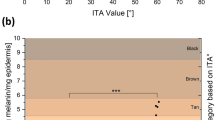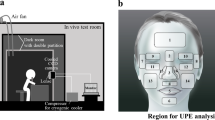Abstract
IT is known that the ultra-violet wave-lengths responsible for producing vasodilatation or erythema penetrate only a short way into human skin1,2. These studies, however, do not by themselves exclude a direct action of ultra-violet light on the blood vessels as the cause of the characterstic erythema, for they have shown that a small fraction (up to 20 per cent) of these wave–lengths is able to penetrate through the avascular epidermis to the vascular corium. Further evidence that the effect of ultra–violet light on the skin blood-vessels is an indirect one would therefore seem of interest.
This is a preview of subscription content, access via your institution
Access options
Subscribe to this journal
Receive 51 print issues and online access
$199.00 per year
only $3.90 per issue
Buy this article
- Purchase on Springer Link
- Instant access to full article PDF
Prices may be subject to local taxes which are calculated during checkout
Similar content being viewed by others
References
Bachem, A., and Reed, C. J., Amer. J. Physiol., 97, 86 (1931).
Hansen, K. G., Acta Radiol., Supp., 71 (1948).
Lewis, T., “The Blood Vessels of the Human Skin and their Responses” (Shaw, London, 1927).
Eidinow, A., Brit. Med. J., ii, 160 (1927).
Lucas, N. S., Biochem. J., 25, 57 (1931).
Kline, R., and Baer, R. L., J. Invest. Dermat., 10, 397 (1948).
Author information
Authors and Affiliations
Rights and permissions
About this article
Cite this article
PARTINGTON, M. Indirect Effect of Ultra-Violet Light on Skin Blood Vessels. Nature 174, 134–135 (1954). https://doi.org/10.1038/174134c0
Issue Date:
DOI: https://doi.org/10.1038/174134c0
This article is cited by
-
The Effect of Ultraviolet Light on Isolated Cutaneous Blood Vessels**From the Mayo Clinic and Mayo Foundation: Section of Dermatology. Read at the Fifth International Congress on Photobiology, Hanover, New Hampshire, August 26 to 30, 1968.
Journal of Investigative Dermatology (1969)
-
Effect of Oral and Topical 17α-Methyl-B-Nortestosterone on Sebum Production and Plasma Testosterone**From the Departments of Dermatology and Biochemistry, Boston University School of Medicine and the Evans Memorial Department of Clinical Research, University Hospital, Boston University Medical Center, Boston, Massachusetts 02118.
Journal of Investigative Dermatology (1969)
Comments
By submitting a comment you agree to abide by our Terms and Community Guidelines. If you find something abusive or that does not comply with our terms or guidelines please flag it as inappropriate.



